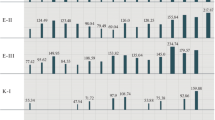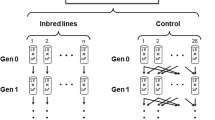Abstract
Est-6 polymorphism was studied by extensive sampling of Drosophila melanogaster populations in different years and in different places in the Venetia region of North-East Italy. In many cases an unexpected excess of homozygous genotypes was found. The excess is relatively high in late August and early September and it is followed by a progressive decrease with time toward late autumn, when the population size undergoes a progressive increase.
It is postulated that in late August an apparent natural population of D. melanogaster virtually consists of several micropopulations; in each of which geographic isolation induces a certain degree of inbreeding. The excess of homozygous genotypes decreases with time since the progressive increase of the effective population size gives progressively more opportunities to the original micropopulations of coming into contact and of intermizing.
Similar content being viewed by others
References
Bell, J.B., R.J. MacIntyre & A.P. Olivieri (1972). Induction of null-activity mutants for the acid phosphatase-1 gene in Drosophila melanogaster. Biochem. Genet. 6: 205–216.
Birley, A.J. & J.A. Beardmore (1972). Manifoid large selective effects in an enzyme polymorphism. Fifth European Marine Biology Symposium, pp. 81–100.
Boyer, J.F. (1974). Clinal and size-dependent variation at the LAP locus in Mytilus edulis. Biol Bull. mar. biol. Lab. Woods Hole 147: 535–549.
Charlesworth, B. & J.T. Giesel (1972), Selection in populations with overlapping generations, IV. Fluctuations in gene frequency with density-dependent selection. Am. Nat. 106, 949: 402–411.
Danieli, G.A., R. Costa & E. Rodinò (1975). Analisi del locus Esterasi-6 in Drosophila melanogaster: variabilità genetica in popolazioni naturali. Atti Aecad. naz. Lineei 58: 441–446.
Dickinson, W.J. & D.T. Sullivan (1975). Gene-enzyme systems in Drosophila. Springer, Berlin-Heidelberg-New York.
Gibson, J. (1970). Enzyme flexibility in Drosophila melanogaster. Nature 227: 959–960.
Gooch, J. & T.J.M. Schopf (1971). Genetic variation in the marine Ectoproct Schizoporella errata. Biol. Bull. mar. biol. Lab. Woods Hols 141: 235–246.
Johnson, F.M. (1964b). A recessive esterase deficiency in Drosophila. J. Hered. 55: 76–78.
Kojima, K.I. & K.M. Yarbrough (1967). Frequency-dependent selection at the Esterase-6 locus in Drosophila melanogaster. Proc. natn. Acad. Sci. U.S.A. 57: 645–649.
Manwell, C. & C.M.A. Baker (1969). Hybrid proteins, heterosis and the origin of species. I. Unusual variation of Polychaete Hyalinoecia ‘Nothing dehydrogenases’ and of quail Coturnix Erythrocyte enzymes. Comp. Biochem. Physiol. 28: 1007–1028.
Manwell, G. & C.M.A. Baker (1970). Molecular biology and the origin of species: heterosis, protein polymorphism and animal breeding. Sidgwick & Jackson, London, p. 18.
Moran, P.A.P. (1962). The statistical processes of evolutionary theory. Oxford, The Clarendon Press.
Rodinò, E. & A. Maetini (1971). Est 6 V: a new allele at the Est-6 locus in natural populations of D. melanogaster. Drosoph. Inf. Serv. 46: 139.
Rodinò, E. & G.A. Daniell (1972). Three more alleles at the locus Est-6 in Drosophila melanogaster. Drosoph. Inf. Serv. 48: 77.
Trippa, G., Danieli, G.A., Scozzari, R. & R. Costa (1977). An isoelectro-phoretic quantitative allele at the locus Est 6 in the natural population of D. Melanogaster. Atti Ass. Genet. Ital. 22 (in press).
Wallace, B. (1966a). On the dispersal of Drosophila. Am. Nat. 100: 551–563.
Wright, S. (1943). Isolation by distance. Genetics 28: 114–138.
Wright, T.R.F. (1963). The genetics of an esterase in Drosophila melanogaster. Genetics 48: 787–801.
Wright, T.R.F. & R.J. MacIntyre (1965). Heat-stable and heat-liable Esterase-6F enzymes in Drosophila melanogaster produced by different Est-6F alleles. J. Elisha Mitchell scient. Soc. 81: 17–19.
Author information
Authors and Affiliations
Rights and permissions
About this article
Cite this article
Danieli, G.A., Costa, R. Transient equilibrium at the est-6 locus in wild populations of Drosophila melanogaster. Genetica 47, 37–41 (1977). https://doi.org/10.1007/BF00122436
Received:
Accepted:
Published:
Issue Date:
DOI: https://doi.org/10.1007/BF00122436




